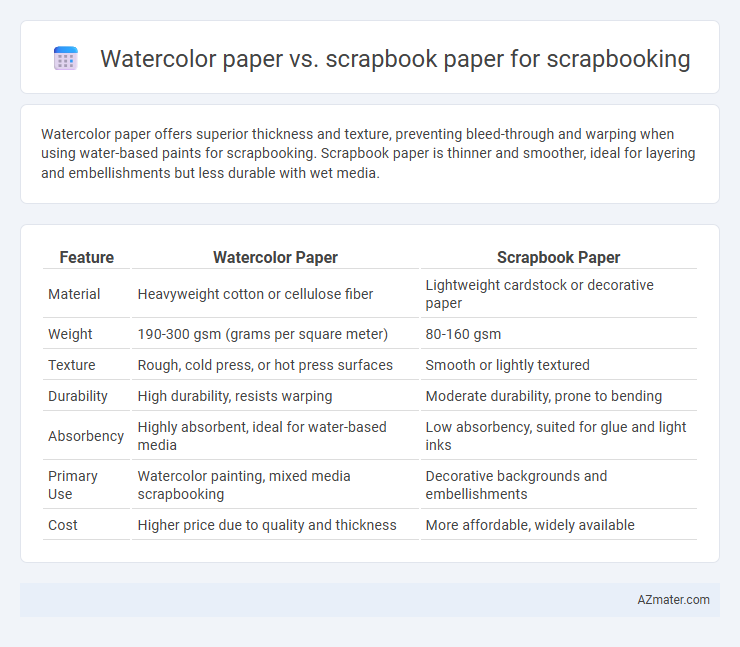Watercolor paper offers superior thickness and texture, preventing bleed-through and warping when using water-based paints for scrapbooking. Scrapbook paper is thinner and smoother, ideal for layering and embellishments but less durable with wet media.
Table of Comparison
| Feature | Watercolor Paper | Scrapbook Paper |
|---|---|---|
| Material | Heavyweight cotton or cellulose fiber | Lightweight cardstock or decorative paper |
| Weight | 190-300 gsm (grams per square meter) | 80-160 gsm |
| Texture | Rough, cold press, or hot press surfaces | Smooth or lightly textured |
| Durability | High durability, resists warping | Moderate durability, prone to bending |
| Absorbency | Highly absorbent, ideal for water-based media | Low absorbency, suited for glue and light inks |
| Primary Use | Watercolor painting, mixed media scrapbooking | Decorative backgrounds and embellishments |
| Cost | Higher price due to quality and thickness | More affordable, widely available |
Introduction to Scrapbooking Papers
Watercolor paper and scrapbook paper serve different purposes in scrapbooking, with watercolor paper known for its thick, textured surface that withstands wet media and adds artistic depth. Scrapbook paper is typically thinner, available in a wide range of colors, patterns, and acid-free options designed specifically for preserving memories and photos. Choosing between these papers depends on the desired aesthetic, durability, and the type of mixed media techniques incorporated into the scrapbook project.
What is Watercolor Paper?
Watercolor paper is a specially designed heavy-weight paper made to absorb water without warping or deteriorating, typically composed of 100% cotton or cellulose fibers. It features a textured surface that enhances paint adhesion and color vibrancy, ideal for mixed media projects where water-based paints are used. Unlike scrapbook paper, which is thinner and smoother, watercolor paper provides durability and flexibility crucial for wet mediums in scrapbooking.
What is Scrapbook Paper?
Scrapbook paper is a lightweight, decorative paper specifically designed for crafting and scrapbooking, featuring a variety of colors, patterns, and textures ideal for embellishments and backgrounds. Unlike heavyweight watercolor paper, which is thick and textured to support wet media without warping, scrapbook paper lacks the absorbency and durability needed for painting techniques. Choosing scrapbook paper enhances visual appeal and layering in scrapbook projects but is not suitable for watercolor or mixed media applications.
Texture and Surface Differences
Watercolor paper features a thick, textured surface designed to absorb water and pigment, providing durability and preventing warping during wet applications, ideal for detailed artistic scrapbooking. Scrapbook paper typically has a smoother, thinner surface with a variety of decorative prints and finishes, prioritizing aesthetics over absorbency and structural strength. The pronounced texture of watercolor paper enhances tactile richness and dimensionality, while scrapbook paper offers a flat, uniform base suited for layering and adhesive use.
Weight and Thickness Comparison
Watercolor paper typically ranges from 140 lb (300 gsm) to 300 lb (640 gsm), providing a thick, sturdy surface ideal for wet media and heavy embellishments, while scrapbook paper generally weighs around 65 lb (176 gsm), offering a lighter, thinner option suited for layering and decorative elements. The thickness of watercolor paper, often 0.3 mm or more, ensures durability and resistance to warping, whereas scrapbook paper averages about 0.15 mm in thickness, making it more flexible but less supportive of heavy mediums. For scrapbooking, choosing watercolor paper enhances longevity and texture, while scrapbook paper allows for easier folding and layering without added bulk.
Color and Print Compatibility
Watercolor paper offers superior color vibrancy and saturation due to its textured surface, which absorbs inks and pigments deeply, resulting in more vivid and long-lasting prints for scrapbooking projects. Scrapbook paper, typically smoother and thinner, supports basic printing needs but may exhibit color fading or bleeding when exposed to heavy ink applications or water-based markers. For optimal color fidelity and print compatibility in scrapbooking, watercolor paper is preferred when using high-quality inks, while scrapbook paper suits casual and decorative printing with lighter color demands.
Best Uses for Watercolor Paper in Scrapbooking
Watercolor paper is ideal for scrapbookers seeking textured backgrounds and vibrant color absorption, enhancing ink and paint applications without warping. Its heavyweight composition supports mixed media, such as watercolors, acrylics, and stamping, providing durability and rich artistic effects. Using 140 lb cold-pressed watercolor paper allows for professional-quality pages that withstand layering and embellishments in scrapbooking projects.
Advantages of Scrapbook Paper for Crafting
Scrapbook paper offers a wide range of patterns, textures, and colors specifically designed for creative projects, making it ideal for scrapbooking and crafting. Its lightweight nature allows for easy cutting, folding, and layering without adding bulk, which is essential for detailed designs and embellishments. Unlike watercolor paper, scrapbook paper frequently includes acid-free and archival-quality options, ensuring long-lasting preservation of memories and artwork.
Cost and Availability Considerations
Watercolor paper typically costs more due to its thicker texture and acid-free properties, making it more durable for scrapbooking projects that require water-based mediums. Scrapbook paper is widely available in various patterns and finishes at lower prices, offering budget-friendly options for decorative layering. Choosing between the two depends on the desired quality and specific use, balancing cost efficiency with material performance.
Choosing the Right Paper for Your Scrapbook Projects
Watercolor paper offers a textured surface ideal for mixed-media scrapbooking, providing durability and excellent ink absorption for vibrant artwork. Scrapbook paper, typically lighter and smoother, is designed specifically with decorative patterns and ease of layering in mind, making it perfect for photo mats and embellishments. Choosing the right paper depends on your project's needs: opt for watercolor paper when incorporating paints or heavy mediums, and select scrapbook paper for traditional layering and design versatility.

Infographic: Watercolor paper vs Scrapbook paper for Scrapbooking
 azmater.com
azmater.com